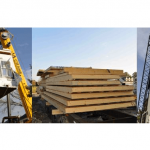How Can You Get a Modular Home to My Site?
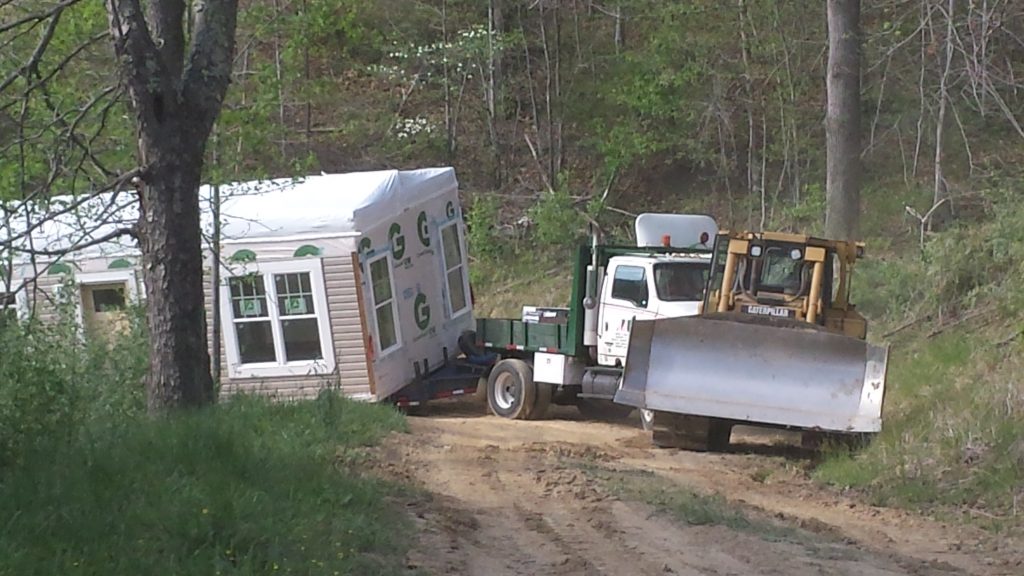

First, What Makes a Modular Home Modular?
A modular home is basically a stick built home that is built offsite and then transported to the site in modules. When designing a modular home the architect, engineer, or designer takes a standard home design and then based on that design, determines the best way to modularize or break it up into pieces that can be transported. These pieces, or modules, are then individually built in a factory. Because of state highway limitations and the need to gain access to building sites, typical module sizes can vary by region.
In the northeast and mid-Atlantic where modular home construction is popular, highways are much older than in the rest of the country. Underpasses are lower and roads and bridges are narrower. This has placed more restrictive size limits on the modules produced in this area. Module sizes are limited to being under 16 feet wide and a maximum of 76 feet long. In the mid-west and plains states highways are wide and underpasses are tall. Many times home modules that are 15 feet tall, 18-20 feet wide and up to 93 feet long can be shipped. In fact, in a few limited areas, a home can be built in one module that is 60 feet long and 32 feet wide. Imagine trying to pass that on the road!
How is a Module Transported?
The modules are typically put on an I-beam carrier that is specially built to protect the module from the rigors of navigating hills, bends and potholes on today’s roads. The carriers are only attached to the module temporarily during transport. On set day, the homes modules are raised from the carrier and the carriers are stacked and returned to the factory.
A specialty truck known as a toter pulls the carriers that support the modules as they travel to the home site. A basic toter has a fixed hitch used to pull the carriers to most sites. However, there are special toters that have the ability to move the hitches to help the truck and carrier navigate some of the sharp turns and narrow roads. These typically have a single rear axle and are very short. They work very well when transporting a modular home module through very tight locations.
How Did they Get that Modular Home There?
Getting all of the modules of a home to a home site is the first step to erecting a modular home on a site. Needless to say, reputable modular home companies have gotten very good at getting modules to sites that many would think required a helicopter for delivery. There are other special tools and equipment that can get large modules to difficult sites. Excavation equipment is used to navigate steep hills, tight turns, and muddy sites. Other equipment such as Jades, Tugs, and Platypus’ have been developed just to get large modules to sites that otherwise would be inaccessible.
Related: PREFAB VERSUS MODULAR – WHAT’S THE DIFFERENCE?
Traveling on main highways is typically the easy part. Once a truck carrying a module gets off the main road, that’s when navigating the obstacles becomes an art form. Here are some obstacles that are found when delivering modules to home sites.
Tight Bends and Narrow Roads
 Tight bends and switch-backs on roads are a common occurrence. Having a small truck and a movable hitch can make the difference of getting a module to the home site or not. Planning takes place long before the home arrives to some jobsites to insure the modules are small enough to navigate the road and that the carrier the module is placed is also the shortest possible to get to the home site.
Tight bends and switch-backs on roads are a common occurrence. Having a small truck and a movable hitch can make the difference of getting a module to the home site or not. Planning takes place long before the home arrives to some jobsites to insure the modules are small enough to navigate the road and that the carrier the module is placed is also the shortest possible to get to the home site.
Narrow Bridges
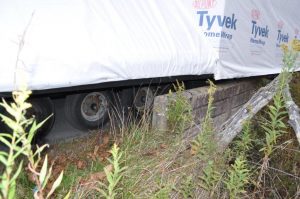 Narrow bridges and roads also present obstacles. Bridges can have narrow road ways, high sides, and even low weight limits. It is important to identify these types of issues well before the home is on the way to the jobsite. Just because a narrow bridge exists on the route to the home site doesn’t mean a module can’t be delivered to the site. It just means that those involved in doing the delivery need to be prepared with the proper tools and equipment to navigate them quickly with no damage to the modules themselves.
Narrow bridges and roads also present obstacles. Bridges can have narrow road ways, high sides, and even low weight limits. It is important to identify these types of issues well before the home is on the way to the jobsite. Just because a narrow bridge exists on the route to the home site doesn’t mean a module can’t be delivered to the site. It just means that those involved in doing the delivery need to be prepared with the proper tools and equipment to navigate them quickly with no damage to the modules themselves.
Powerlines
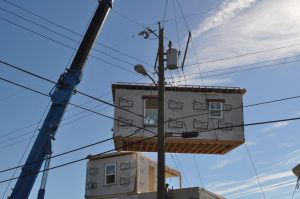 Power lines present obstacles not only for access but for safety. If a powerline is located on the site, then each module has to be able to navigate underneath of it and then be lifted while maintaining a safe distance of 15 feet from any metal such as a crane boom or cable. Should a line be too close, options exist to temporarily remove the line if it is an obstruction or to turn off (de-energize) the line if it just a matter of distance. In every case, safety for the set crews, transport team, and others on the site is paramount.
Power lines present obstacles not only for access but for safety. If a powerline is located on the site, then each module has to be able to navigate underneath of it and then be lifted while maintaining a safe distance of 15 feet from any metal such as a crane boom or cable. Should a line be too close, options exist to temporarily remove the line if it is an obstruction or to turn off (de-energize) the line if it just a matter of distance. In every case, safety for the set crews, transport team, and others on the site is paramount.
Trees and Hills
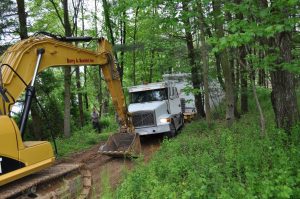 Nature is wonderful. Trees can take decades to reach maturity. On many homes sites, trees can be removed or trimmed to provide access to large modules. However, on some sites the damage would just be too great or it just simply isn’t acceptable to clear the path to the site. Add to that the terrain and it is a recipe for a difficult delivery. With patience and planning (and the right equipment), a home’s modules can usually be delivered to the most challenging sites.
Nature is wonderful. Trees can take decades to reach maturity. On many homes sites, trees can be removed or trimmed to provide access to large modules. However, on some sites the damage would just be too great or it just simply isn’t acceptable to clear the path to the site. Add to that the terrain and it is a recipe for a difficult delivery. With patience and planning (and the right equipment), a home’s modules can usually be delivered to the most challenging sites.
Mountain Tops
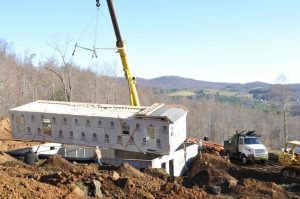 Home buyers wait for years to find that perfect lot for their last home. When building on a mountain top, many obstacles have to be overcome just to get to the driveway for the jobsite. Once the truck and the modules arrive at the site, the real work begins. Some driveways to mountain top sites and can be a mile long and can have steep inclines that a 4 wheel drive truck has challenges overcoming. Heavy loaders are needed to pull cranes, trucks, and modules to the site to deliver the dream home to the right location for that forever view.
Home buyers wait for years to find that perfect lot for their last home. When building on a mountain top, many obstacles have to be overcome just to get to the driveway for the jobsite. Once the truck and the modules arrive at the site, the real work begins. Some driveways to mountain top sites and can be a mile long and can have steep inclines that a 4 wheel drive truck has challenges overcoming. Heavy loaders are needed to pull cranes, trucks, and modules to the site to deliver the dream home to the right location for that forever view.
Water view Sites
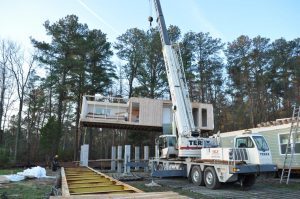 Engineering can overcome many issues. Designing a foundation for a site with a water table that is barely a foot below the surface requires great ingenuity. Now imagine having to deliver modules to that site on a carrier that with a combined weight, can exceed 80,000 pounds. The crane used to set those modules on the foundation can weigh even more. Specialty mats are required just to get the modules onto the home site and equipment such as loaders or dozers may be needed to get the modular sections onto those mats.
Engineering can overcome many issues. Designing a foundation for a site with a water table that is barely a foot below the surface requires great ingenuity. Now imagine having to deliver modules to that site on a carrier that with a combined weight, can exceed 80,000 pounds. The crane used to set those modules on the foundation can weigh even more. Specialty mats are required just to get the modules onto the home site and equipment such as loaders or dozers may be needed to get the modular sections onto those mats.
Can You Get a Modular Home to Every Site?
This primer on getting modules to home sites has only covered some of the methods used to get large modules to difficult sites. Don’t assume because you see obstacles or issues with your home site that using modular construction isn’t an option. With a little ingenuity and patience, there are very few sites that are inaccessible for delivery of a modular home.? Don’t assume you have to settle for a site built home. Contact the experts to see if you can use the modular advantage when building your new home.
Note: This post was based on a request from a reader that wanted to learn more about this subject. If you have a topic that you would like to learn more about, please email your suggestion to info@impresamodular.com.
The post How Can You Get a Modular Home to My Site? appeared first on Impresa Modular.




